Martienssen W., Warlimont H. (Eds.). Handbook of Condensed Matter and Materials Data
Подождите немного. Документ загружается.


782 Part 4 Functional Materials
6
4
2
0
–2
–4
0246810
∆
Ni (wt %)
Ti, Mn, Cr, C, Cu (wt %)
Mn
Ti
Cr
Cu
C
Fig. 4.3-36 Displacement of the composition correspond-
ing to the minimum thermal expansion coefficient of Fe
−
Ni
alloys by the addition of Ti, Mn, Cr, Cu, and C [3.17]
8
6
4
2
0
0246810
∆
(× 10
–6
)
α
Ti, Mn, Cr, C, Cu (wt %)
C
Ti
Cu
Mn
Cr
Fig. 4.3-37 Increase of the minimum value of thermal ex-
pansion coefficient of Fe
−
Ni alloys by the addition of Ti,
Mn, Cr, Cu, and C [3.17]
and its composition is near the boundary between the
bcc and fcc phase fields.
Fe–Ni-Based Invar Alloys. An iron alloy containing 34
to 36.5 wt% Ni is well known as a commercial invar
material. The materials C < 0.12 wt%, Mn < 0.50 wt%,
and Si < 0.50 wt% are generally added for metallurgi-
cal purposes. Figure 4.3-35 [3.41] shows the thermal
expansion curves of some Fe
−
Ni alloys.
The thermal expansion of invar alloys is af-
fected significantly by the addition of third elements,
4
3
2
1
0
0
0
0
100 200 300 400 500 600 700
T(K)
∆
l/l (×10
–3
)
Fe–36 wt% Ni
T
a
= 1073 K
873 K
673 K
Cold-swaged
Fig. 4.3-38 Effect of thermal annealing at a temperature T
a
and of mechanical treatment on the thermal expansion of
Fe–36 at.% Ni invar alloy [3.41]
by cold working and by thermal treatment as
shown in Fig. 4.3-36 [3.17], Fig. 4.3-37 [3.17] and
Fig. 4.3-38 [3.41].
Invar is an austenitic alloy and cannot be hard-
ened by heat treatment. The effect of heat treatment
on the TEC α depends on the method of cooling af-
ter annealing. Air cooling or water quenching from
the annealing temperature results in a reduction of α
butatthesametimeα becomes unstable. In order
to stabilize the material, annealing at low temperature
and slow cooling to room temperature are neces-
sary.
Following heat treatments for an optimum and stable
magnitude of α are recommended: 830
◦
C, 1/2h, wa-
ter quenching; 315
◦
C, 1 h, air cooling; 95
◦
C, 20 h,
air cooling. Cold working reduces α. But before use
in high precision instruments a stress-relief anneal at
320 to 370
◦
C for 1 h followed by air cooling is re-
quired.
The mechanical properties of some invar-type alloys
are listed in Table 4.3-25 [3.42].
Part 4 3.2

Magnetic Materials 3.2 Soft Magnetic Alloys 783
Table 4.3-25 Thermal expansion coefficient, α and mechanical properties of invar alloys for practical use [3.42]
Composition (wt%) α at RT (10
−6
K
−1
) Vickers hardness Tensile stress (MPa)
Invar Fe
−
36Ni <2 150–200 500–750
Super Invar
a
Fe
−
32Ni
−
4Co <0.5 150–200 500–800
Stainless Invar
b
Fe
−
54Co
−
9Cr <0.5
High strength Invar Fe
−
Ni
−
Mo
−
C
c
<4 1250
Fe
−
Ni
−
Co
−
Ti
d
<4 300–400 1100–1400
a
Masumoto, 1931
b
Masumoto, 1934
c
Yokota et al., 1982
d
Yahagi et al., 1980
Table 4.3-26 Thermal expansion coeffcient of invar 36 and free-cut invar [3.17]
Temperature α(×10
−6
K
−1
)
As annealed As cold-drawn
(
◦
C) Invar 36 Free-cut Invar 36 Invar 36 Free-cut Invar 36
25–100 11.18 1.60 0.655 0.89
25–200 1.72 2.91 0.956 1.62
25–300 4.92 5.99 2.73 3.33
25–350 6.60 7.56 3.67 4.20
25–400 7.82 8.88 4.34 4.93
25–450 8.82 9.80 4.90 5.45
25–500 9.72 10.66 5.40 5.92
25–600 11.35 12.00 6.31 6.67
25–700 12.70 12.90 7.06 7.17
25–800 13.45 13.60 7.48 7.56
25–900 13.85 14.60 7.70 8.12
Table 4.3-27 Some physical properties of invar alloys [3.17]
Property Value
Melting point 1.425
◦
C 2600
◦
F
Density 8gcm
−3
(8.0–8.13) 500 lb ft
−3
Thermal electromotive force to copper (0–96
◦
C) 9.8 µV/K
Specific resistance (Annealed) 82 ×10
−6
Ω cm (81–88) 495 Ω circ. mil/ft
Temperature coefficient of electric resistivity 1.21 × 10
−3
K
−1
0.67× 10
−3 ◦
F
−1
Specific heat 0.123 cal/g K (25–100
◦
C) 0.123 Btu/lb
◦
F (77–212
◦
F)
Thermal conductivity 0.0262 cal/sec cm K (22–100
◦
C) 72.6 Btu in./hr ft
2 ◦
F (68–212
◦
F)
Curie temperature 277
◦
C (277–280
◦
C) 530
◦
F
Inflection temperature 191
◦
C 375
◦
F
Modulus of elasticity (in tension) 15.0×10
10
Pa 21.4×10
6
lb in.
−2
Temperature coefficient of elastic modulus +50 × 10
−5
K
−1
(16–50
◦
C) +27 × 10
−5 ◦
F
−1
(60–122
◦
F)
Modulus of rigidity 5.7×10
10
Pa 8.1×10
6
lb in.
−2
Temperature coefficient of rigidity modulus +58 × 10
−5
K
−1
+30× 10
−5 ◦
F
−1
Posson’s ratio 0.290
Part 4 3.2
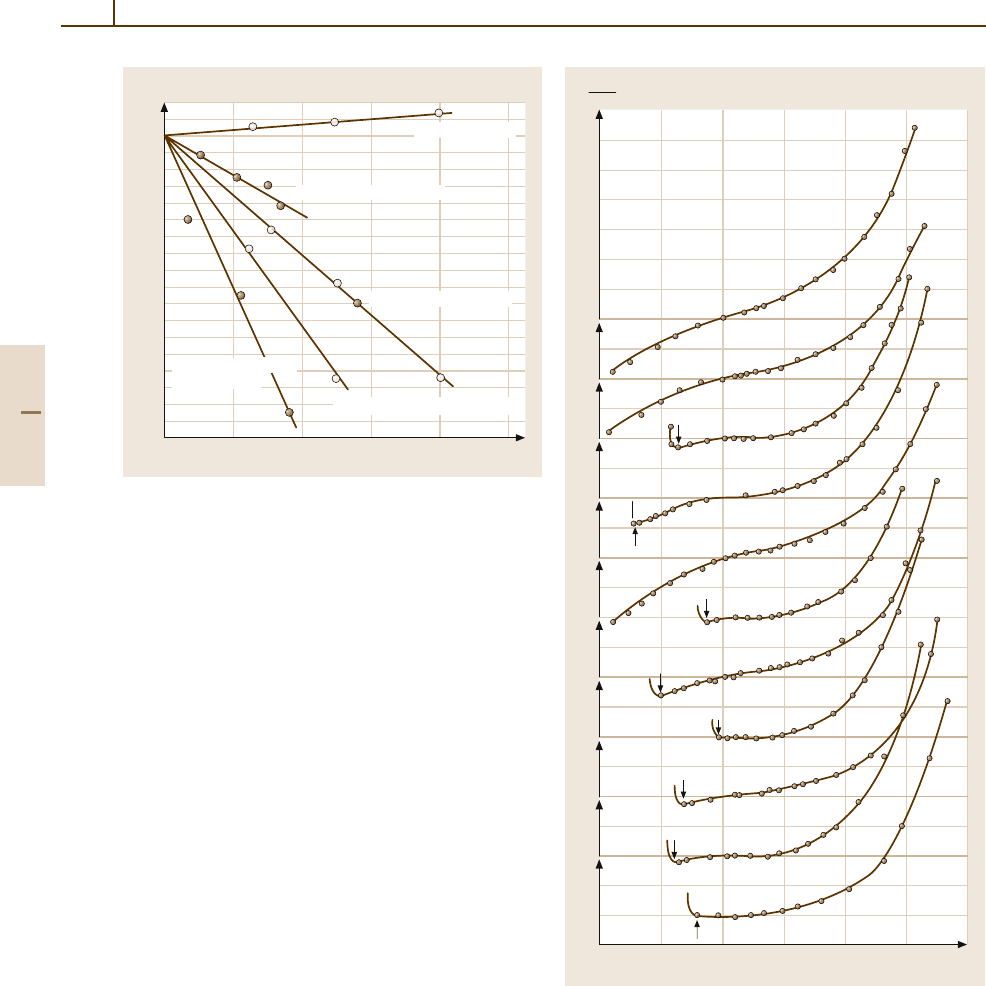
784 Part 4 Functional Materials
4
2
0
2
4
6
8
–10
2
4
6
8
–20
2
4
6
8
–30
2
4
246810
T
c
(°C)
∆
P(kbar)
Ni(T
c
= 360 °C)
30Mn–Fe(T
N
= 148°C)
36Ni–Fe(T
c
= 210°C)
30Ni–Fe(T
c
= 80°C∼130°C)
37Fe–52Co–11Cr
(T
c
=131°C)
Fig. 4.3-39 The displacement of the Curie point ∆T
c
vs.
pressure in Fe
−
Ni invar alloys [3.43] and in Fe
−
Co
−
Cr
invar alloy [3.44]. The results for Ni [3.43] and for
a 30Mn
−
Fe alloy [3.44] are also shown for comparison.
Numerical values in parentheses show the Curie or Néel
point at atmospheric pressure
Invar-type alloys show large effects of pressure on
magnetization and on the Curie temperature, which sug-
gests a high sensitivity to the interatomic spacing, as
shown in Fig. 4.3-39 [3.17].
Thermal expansion coefficients of invar 36 and
free-cut invar 36 (containing S and P, or Se) be-
tween 25 and 900
◦
C are listed in Table 4.3-26 [3.17].
Some physical properties of Invar alloys are given in
Table 4.3-27 [3.17].
Low thermal expansion coefficients are observed at
ternary and quaternary Fe-alloy systems, too. The com-
position Fe–32 wt% Ni–4 wt% Co was the starting point
of superinvar, whose TEC α is in the order of 10
−7
K
−1
.
The thermal expansion curves of different variants are
shown in Fig. 4.3-40 [3.17].
In order to improve the corrosion resistance of in-
var alloys, “stainless invar” was developed. The basic
composition is Fe–54 wt% Co–9.5 wt% Cr. Stainless in-
var has the bcc structure at room temperature in the
equilibrium state. As an invar material, it is used af-
ter quenching from a high temperature to retain the fcc
structure [3.17].
To improve the mechanical properties two types
of high strength invar materials were developed:
a work-hardening type based on Fe
−
Ni
−
Mo
−
C, and
12
10
8
6
4
2
0
2
0
2
0
2
0
2
0
2
0
2
0
2
0
2
0
2
0
2
0
–200 –100 0 100 200 300 400
T(°C)
(× 10
4
)
δ
l
l
Fe = 63.5%
Ni = 36.5%
Ni=34.0%
Fe=62.5%, Co=3.5%
Ni = 32.5%
Fe = 63.5%, Co = 4.0%
Ni = 33.5%
Fe = 62.5%, Co = 4.0%
Ni = 31.5%
Fe = 63.5%, Co = 5.0%
Ni = 33.0%
Fe = 63.0%, Co = 4.0%
Ni=32.5%
Fe=62.5%, Co=5.0%
Ni=30.5%
Fe=63.5%, Co=6.0%
Ni=31.5%
Fe=62.5%, Co=6.0%
Ni=31.0%
Fe=64.0%, Co=5.0%
+Mn=0.35%
+Mn=0.38%
Ni=31.0%
Fe=63.0%, Co=6.0%
Ar
3
Fig. 4.3-40 Thermal expansion curves of super invar al-
loys [3.17]
a precipitation-hardening type Fe
−
Ni
−
Co
−
Ti alloy
[3.17].
Fe–Pt-Based Invar Alloys. Among the ordered phases
of the Fe
−
Pt system (Fig. 4.3-41 [3.17]), the Fe
3
Pt phase
shows the invar type thermal expansion anomaly. In
Part 4 3.2
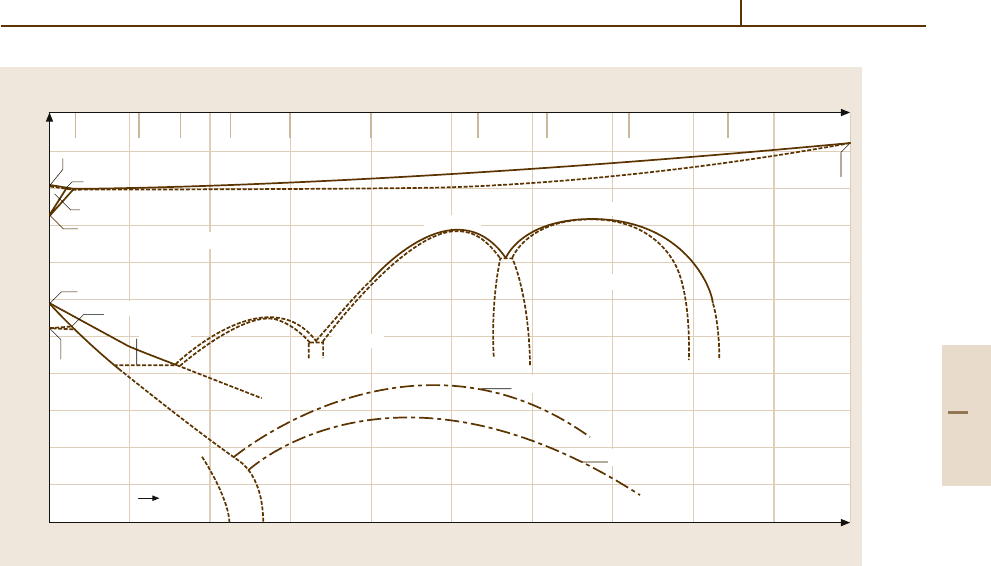
Magnetic Materials 3.2 Soft Magnetic Alloys 785
Fe
2200
2000
1800
1600
1400
1200
1000
800
600
400
200
0
10 20 30 40 50 60 70 80 90 100
10 30 40 50 60 70 80 85 90 95
Pt (at.%)
Pt (wt %)T(K)
Fe–Pt
1811 K
1792 K
1667 K
( –Fe)
δ
1185 K
1043 K
γ
( –Fe, Pt) or
γ
T
c
>823 K
(Fe
3
Pt)
<973 K
(Fe
3
Pt)
( –Fe)
α
( –Fe)
α
(FePt)
≅1573 K
≅1623 K
(FePt
3
)
T
c
(ordered)
T
c
( )
γ
2042 K
Fig. 4.3-41 Fe
−
Pt phase diagram. Dashed-dotted lines: Curie temperature T
c
order to obtain a well ordered state, a long annealing
time is necessary (600
◦
C, 160 h). Disordered fcc alloys
which show invar anomalies, too, may be obtained by
rapid quenching from above the order–disorder trans-
formation temperature. The Curie temperature of the
disordered state is lower than that of the ordered state.
A high negative value of α is observed just below the
Curie temperature, particularly for disordered alloys.
Annealed alloys containing 52 to 54 wt% Pt have small
TEC and those containing 52.5to53.5 wt% Pt show
negative values of α, Fig. 4.3-42 [3.17].
Fe–Pd-Based Invar Alloys. Alloys of Fe
−
Pd (see
Fig. 4.3-43) containing 28 to 31 at.% Pd show invar char-
acteristics, as seen in Fig. 4.3-44 [3.41]. In order to
obtain invar behavior, the alloys are quenched from the
high temperature γ phase field such that phase trans-
formations at lower temperatures are suppressed. As
shown in Fig. 4.3-45 [3.41], the thermal expansion is
strongly decreased by cold deformation, i. e., by dis-
ordering, lattice defects, and internal stresses. After
cold working, an instability of the invar property is
observed.
Part 4 3.2
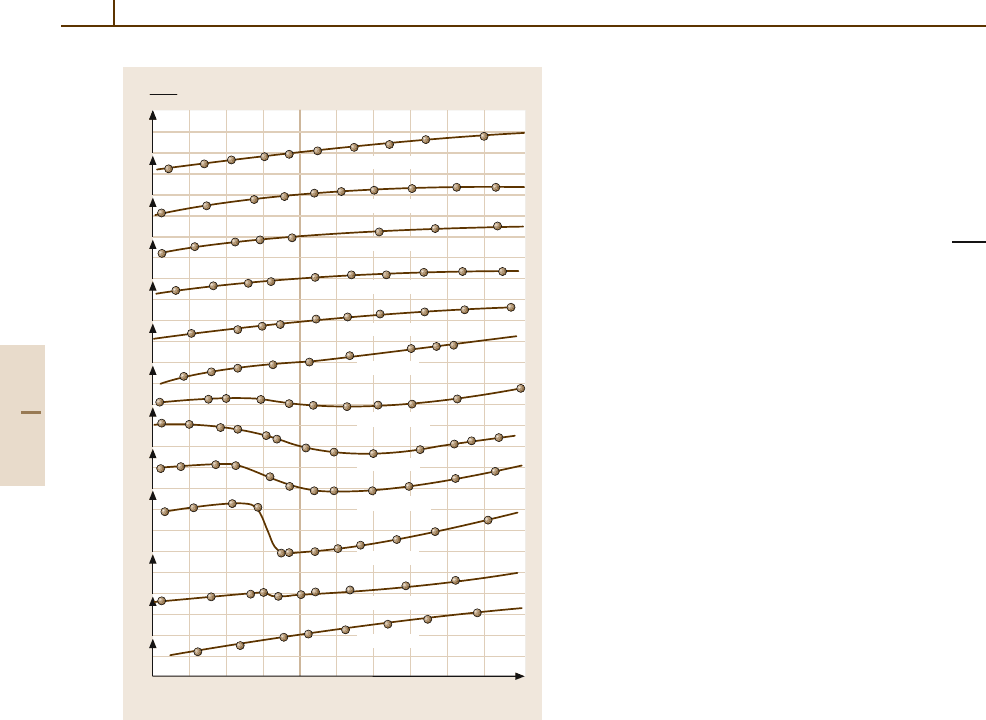
786 Part 4 Functional Materials
2
0
2
0
2
0
2
0
2
0
2
0
2
0
2
0
2
0
4
2
0
2
0
2
0
–2
–200 –100 0 100 200
T(°C)
(× 10
–4
)
δ
l
l
Pt = 65%
Pt = 62%
Pt = 60%
Pt = 57%
Pt = 56%
Pt = 54%
Pt = 53.5%
Pt = 53%
Pt = 52.5%
Pt = 52%
Pt = 51%
Pt = 46%
Fig. 4.3-42 Thermal expansivity curves of Fe
−
Pt al-
loys [3.17]
Other Alloy Systems with Invar Behavior.
Be-
yond the invar-type alloys mentioned, many other
Fe-based alloy systems show invar behavior, for in-
stance, Fe
−
Ni
−
Cr, Fe
−
Ni
−
V, Fe
−
Pt
−
Re, Fe
−
Ni
−
Pt,
Fe
−
Ni
−
Pd, Fe
−
Pt
−
Ir, Fe
−
Cu
−
Ni, and Fe
−
Mn
−
Ni.
Some amorphous melt/quenched alloy systems show
invar characteristics too, e.g., Fe
83
B
17
,Fe
85
P
15
,
Fe
79
Si
9
B
12
. Similarly, amorphous alloys prepared
by sputtering show invar characteristics: Fe
75
Zr
25
,
Fe
72
Hf
28
. Some antiferromagnetic Mn- and Cr-based
alloys also exhibit a remarkable anomaly of thermal
expansion due to magnetic ordering: Pd
64.5
Mn
35.5
,
Mn
77
Ge
23
,Cr
92.5
Fe
4.3
Mn
0.5
,Cr
96.5
Si
3
Mn
0.5
.
Elinvar Alloys
Elinvar or constant-elastic-modulus alloys are based on
work by Guillaume [3.45] and Chevenard [3.46]. They
show a nearly temperature-independent behavior of the
Young’s modulus (E). For technical applications, elin-
var alloys are designed to show the anomaly in the range
of their operating temperature, usually close to room
temperature. Since the resonance frequency f
0
of an os-
cillating body is related to its E modulus by f
0
∼
√
E/
( =density), the thermoelastic properties of elinvar al-
loys are utilized for components in oscillating systems
of the precision instrument industry. In these applica-
tions highly constantresonance frequencies are required.
Typical examples are: resonators in magnetomechanical
filters; balance springs in watches, tuning forks; helical
springs in spring balances or seismographs, as well as
in pressure or load cells. The condition for temperature
compensation of the Young’s modulus E is:
2∆ f/ f ∆T = ∆E/E∆T +α ≈ 0 ,
with T = temperature and α = linear thermal expansion
coefficient. Elinvar characteristics also refer to the tem-
perature independence of the shear modulus G,which
is related to the E modulus via
3/E = 1/G +1/3B
and
E = 2(1 +ν)G = 3(1 −ν)B ,
with B = bulk modulus and ν = Poisson’s ratio.
In ordinary metallic materials, E decreases with in-
creasing temperature according to the variation of the
elastic constants with temperature according to the an-
harmonicity in the phonon energy term. The temperature
compensation of the E-modulus in ferromagnetic and
antiferromagnetic elinvar alloys is caused by an anomaly
in its temperature behavior (∆E effect). As a conse-
quence in ferromagnetic alloys, the E modulus in the
demagnetized state is different from that in the magne-
tized state. The ∆E effect with ferromagnetic elinvar
alloys consists of three parts [3.47]:
∆E = ∆E
λ
+∆E
ω
+∆E
A
.
A schematic description of the components of the
∆E effect in ferromagnetic elinvar alloys is given in
Fig. 4.3-46.
Part 4 3.2
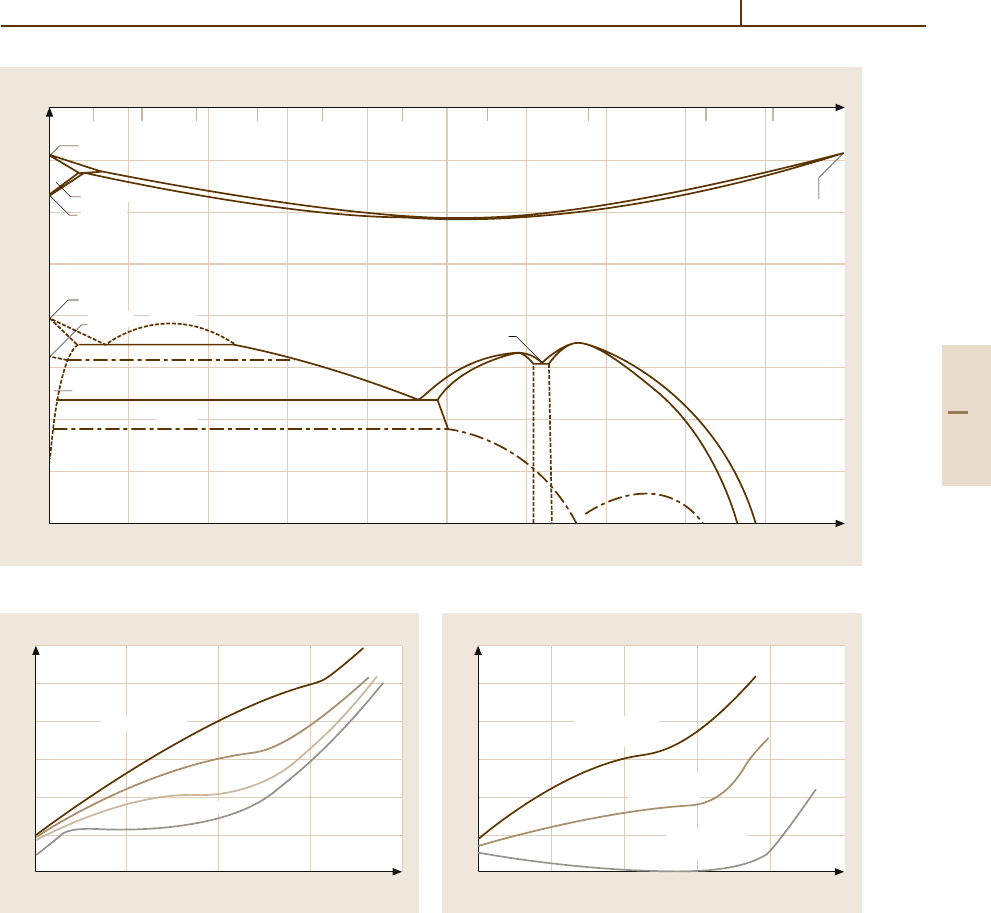
Magnetic Materials 3.2 Soft Magnetic Alloys 787
2000
1800
1600
1400
1200
1000
800
600
400
Fe 10 20 30 40 50 60 70 80 90 Pd
Pd (at.%)
10 20 30 40 50 60 70 80 90 95
Pd (wt%)
Fe–Pd
( –Fe)
δ
γ
( –Fe, Pd)
(FePd
3
)
( –Fe)
α
1811 K
1667 K
1185 K
1043 K
1173 K
1088 K
1029 K
878 K
763 K
≈ 2.3
≈ 46
3.5≈7
48.5
(FePd)
1093 K
61.5
1577 K
54.9
1828 K
T (K)
Fig. 4.3-43 Fe
−
Pd phase diagram. Dashed-dotted lines: Curie temperature T
c
3.0
2.5
2.0
1.5
1.0
0.5
0
300 400 500 600 700
T(K)
(×10
–3
)
∆
l/l
Fe–Pd
33.0 at.% Pd
31.0
29.0
28.0
Fig. 4.3-44 Thermal expansion curves of Fe
−
Pd alloys
rapidly cooled from high temperature [3.41]
These components are attributable to the following
relations:
∆E
λ
=−2/5E
2
λ
s
/σ
i
,
where ∆E
λ
is attributed to the shape magnetostric-
tion (λ
s
) that changes the direction of the spontaneous
magnetization, owing to domain wall motion and ro-
tation processes as a consequence of the influence of
mechanical stresses (σ
i
) or magnetic fields on the unsat-
3.0
2.5
2.0
1.5
1.0
0.5
0
300 400 500 600 700 800
T(K)
(×10
–3
)
∆
l/l
Fe–31 at.%Pd
Quenched
from 1173 K
Cold-rolled
(≈0.5%)
Cold-rolled
(1.0%)
Fig. 4.3-45 Thermal expansion curves of cold-worked Fe–
31 at.% Pd alloy. The rolling ratio is given by percentage
urated state of material [3.48]. The value ∆E
ω
is caused
by forced volume magnetostriction (ω) as a consequence
of changes of the interatomic distances induced by stress
or very high magnetic fields, which lead to a change of
the magnetic interaction [3.49]:
∆E
ω
=−1/9E
2
[(∂ω/∂H)
2
/∂J/∂H] ,
where ∂ω/∂H = forced volume magnetostriction and
∂J/∂H = para-susceptibility. The value ∆E
A
takes the
Part 4 3.2
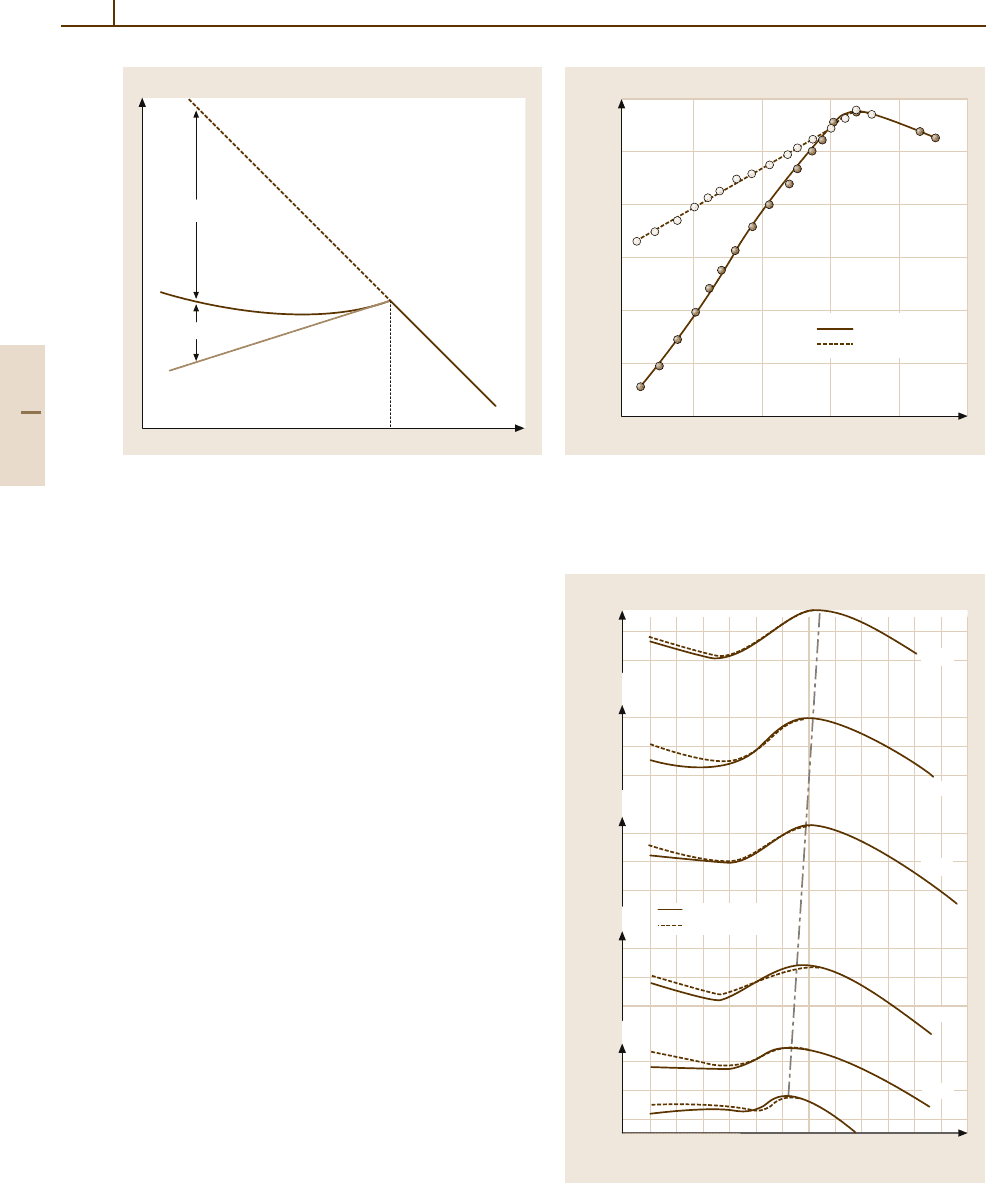
788 Part 4 Functional Materials
T
Young’s modulus E
E
J
E
H
E
λ
∆
E
E
A
∆
E
ω
∆
+
T
c
Fig. 4.3-46 Young’s modulus E as a function of tempera-
ture of ferromagnetic elinvar alloys: E = E modulus in
the absence of a magnetic field, E
H
= E modulus meas-
ured in a magnetic field H, E
J
= E modulus at constant
polarization J
role of the exchange energy into account [3.50]:
∆E
A
∼−ω
s
∼ J
2
s
,
where ω
s
= volume magnetostriction and J
s
= satu-
ration polarization. It originates from the spontaneous
volume magnetostriction ω
s
as a function of the change
of exchange energy with temperature due to the variation
of magnetic ordering up to the Curie temperature.
Ferromagnetic Elinvar Alloys. The development of fer-
romagnetic elinvar alloys is based on affecting the shape
magnetostriction λ
s
by control of internal stresses result-
ing from deformation and/or precipitation hardening.
But this requires a zero or negative temperature coef-
ficient of the E
H
modulus. Based on an Fe–39 wt% Ni
alloy, it can be shown how this behavior is achievable.
Alloys of Fe
−
Ni with 36 to 45 wt% Ni have a positive
sign of the temperature coefficient of the E
H
modulus
(see Fig. 4.3-47 [3.51]).
By addition of 7 wt% Cr this coefficient is reduced
to zero or to slightly negative values. By a deformation it
can be influenced furthermore while the absolute value
Fig. 4.3-48 Young’s modulus E of an Fe
−
39Ni
−
7Cr
−
0.8Be
−
1.0Ti (wt%) alloy as a function of temperature, de-
gree of cold deformation η (%) with and without a magnetic
field H [3.51]
16000
15500
15000
14500
14000
13500
13000
Young’s modulus E (10
10
Pa)
100 200 300 400 500
T(°C)
Fe–39Ni
H= 0
H= 732 A cm
–1
Fig. 4.3-47 E modulus and its dependence on the tempera-
ture of an annealed Fe–39 wt% Ni alloy, with and without
influence of a magnetic field H [3.51]
of E increases [3.51]. Figure 4.3-48 shows the effect
of precipitation-hardening additions such as 0.8wt%Be
20220
20100
19800
19700
19600
19100
19000
18900
18600
18500
18400
18100
18000
17900
0 20 40 60 80 100120 140 160 180 200 220 240260
T(°C)
Young’s modulus E (kp/mm
2
)
85%
70%
40%
20%
10%
0%
H =0
H =732 A /cm
Part 4 3.2

Magnetic Materials 3.2 Soft Magnetic Alloys 789
and 1.0 wt% Ti on the E = f(T ) characteristic. Cold
deformation causes the Curie temperature to rise.
The final processing steps consist of solution anneal-
ing at 1150
◦
C, water quenching, cold deformation, and
a final precipitation annealing at about 600
◦
C. Accord-
ingly commercial elinvar alloys are produced, such as
those listed in Tables 4.3-28, 4.3-29, and 4.3-30.
Apart from the well-tried Fe
−
Ni
−
Cr
−
(Be, Ti)-
based elinvar-type alloys, Fe
−
Ni
−
Mo-based alloys
have gained technical application. Addition of Mo
improves the elastic properties, lowers the Curie tem-
perature, and increases the resistance to corrosion. While
in Europe and the USA, Fe
−
Ni-based elinvar-type al-
loys mainly were developed, in Japan Co
−
Fe-based
elinvar alloys were discovered. Ternary Co
−
Fe
−
Cr al-
loys and quaternary alloys containing Ni (Co-elinvar)
attained significant technical relevance. Distinguishing
Table 4.3-28 Compositions in (wt%) of Fe
−
Ni-based elinvar alloys [3.17]
Bal. Fe
C Ni Cr Ti Mo W Mn Si Al Be Nb Cu V Co P S
Durinal 0.1 42 2.1 2 2
Elinvar Extra 0.04 43 5 2.75 0.6 0.5 0.3 0.35
0.6 42 5.5 2.5 0.5 0.5 0.6
Elinvar New 1 35 5 2 1
Elinvar Original 36 12
0.5–2 33–35 21–5 1–3 0.5–2 0.5–2
0.71 33.5 8.4 2.98 2.4 0.33 0.018 0.01
Iso-elastic 36 8 0.5 (other small constituents)
0.1 36 7.5 0.5 0.6 0.5 0.2
Isoval 0.6 30 2.2 3.2 0.15 0.2 3.8 4.2
M
´
et
´
elinvar 0.6 40 6 1.5 3 2
Ni-Span C 0.03 42.2 5.3 2.5 0.4 0.4 0.4 0.05 <0.04 <0.04
Ni-Span C 902 <0.06 42 5.2 2.3 <0.8 <0.1 0.5
Nivarox CT 0.02 37 8 1 0.8 0.2 0.8
Nivarox CTC 0.2 38 8 1 1
Nivarox M 0.03 31 6 0.7 0.1 0.7
Nivarox M30 30 9 1
Nivarox M40 40 9 1
Nivarox W 36 1 1
Sumi-Span 1 36 9
Sumi-Span 2 0.4 38 11
Sumi-Span 3 42.5 5.5 2.4
Thermelast 4009 40 9 0.5
Thermelast 5409 40 9 0.5
Vibralloy 39 9
40 10
YNiC 0.03 41–43 5.1–5.5 2.2–3 0.5–0.6
marks worth mentioning include: higher Young’s modu-
lus than Fe
−
Ni-based alloys, corrosion resistance, wide
range of temperature compensating of E modulus, and
easy hardening by cold-working.
Antiferromagnetic Elinvar Alloys. In antiferromagnetic
alloys no domains are formed and no ∆E
λ
effect oc-
curs. With antiferromagnetic ordering the ∆E
A
effect
can only be exploited in combination with a pronounced
cubic to tetragonal lattice distortion associated with
antiferromagnetic ordering. This requires methods to de-
velop temperature compensating elastic behavior which
are different from those for ferromagnetic thermoelastic
materials. The development of antiferromagnetic al-
loys with Elinvar properties has been concentrated on
Mn
−
Cu, Mn
−
Ni, and Fe
−
Mn base alloys. In [3.52]
the distinct anomalies of Young’s modulus at the Néel
Part 4 3.2

790 Part 4 Functional Materials
Table 4.3-29 Fe
−
Ni-based commercial elinvar-type alloys and the corresponding values of: density d, melting point T
m
, Curie
temperature T
c
, electrical resistivity ρ, thermal expansion coefficient α, Young’s modulus E, its temperature coefficient e,and
shear modulus G [3.17]
d T
m
T
c
ρ α E e G
(g cm
−3
) (
◦
C) (
◦
C) (µ cm) (10
−6
K
−1
) (10
10
Pa) (10
−5
K
−1
) (10
10
Pa)
Durinal 90 −1.0–1.0
Elinvar 1420–1450 −100 8 7.8–8.3 −0.3–0.3
Elinvar Extra
a
8.15 6.5 18.9 0 6.9
Iso-elastic 88 6.7 18.0 −3.3–2.5 6.4
Métélinvar 260, 295 0
Ni-Span C 8.15 1450–1480 80 7.1 18.9 −1.7–1.7
Ni-Span C 902
a
8.14 1460–1480 160–190 100–120 8.1 17.7–19.6 6.9–7.4
Nivarox CT 8.3 80 97 7.5 18.6 −2.5–2.5
Sumi-Span 1 8.15 −140 100 −10 18.1 0–2.5
Sumi-Span 2 8.08 −190 105 −10 18.1 −1.5–0
b
Sumi-Span 3
a
8.05 −190 110 ≈8 19.2 −1.0–1.0 7.8
Thermelast 4002
a
8.3 100 8.5 18.6 6.4
Thermelast 4005
a
8.3 100 8.3 17.2 6.4
Thermelast 5405
a
8.3 100 8.0 18.6 6.4
Thermelast 5429
a
8.3 100 8.0 18.6 6.4
Vibralloy
a
8.3 300 8 17.4 0
YNiC 8.15 90–180 8.1 19.6 −1.8–1.5 6.5–6.8
a
Properties in the fully aged state
b
Temperature coefficient of the frenquency of proper vibration
Table 4.3-30 Co
−
Fe-based elinvar-type alloys (annealed state). Composition, thermal expansion coefficient α, Young’s modu-
lus E and shear modulus G, and their respective temperature coefficients, e and g [3.17]
Composition in wt% α
a
E
b
e
c
G
b
g
c
Co Fe Cr V Mo W Mn Ni (10
−6
K
−1
) (10
10
Pa) (10
−5
K
−1
) (10
10
Pa) (10
−5
K
−1
)
Co-elinvar 60.0 30.0 10.0 5.1 17.07 6.91 −0.2
51.5 38.5 10.0 8.7 18.84 −1.0 7.55
47.3 34.5 9.1 9.1 7.8 6.61 0.2
27.7 39.2 10.0 23.1 8.1 6.48 −0.3
26.7 50.8 5.8 16.7 7.8 4.99 0.3
17.9 42.8 10.7 28.6 8.3 6.74 0.9
Elcolloy 40.0 35.0 5.0 5.0 15.0 5.0 −0.2
35.0 36.0 5.0 4.0 4.0 16.0 9.0 0.5
Mangelinvar 38.0 37.0 15.0 10.0 9.7 18.0 −1.0
Moelinvar 50.0 32.5 17.5 9.6 7.36 −0.2
45.0 35.0 10.0 10.0 8.5 6.15 0.7
20.0 40.0 20.0 20.0 8.4 7.70 0.9
10.0 45.0 15.0 30.0 9.8 7.85 −0.4
Tungelinvar 50.0 28.5 21.5 7.4 6.45 −0.7
39.0 32.0 19.0 10.0 7.8 8.13 0.4
Part 4 3.2
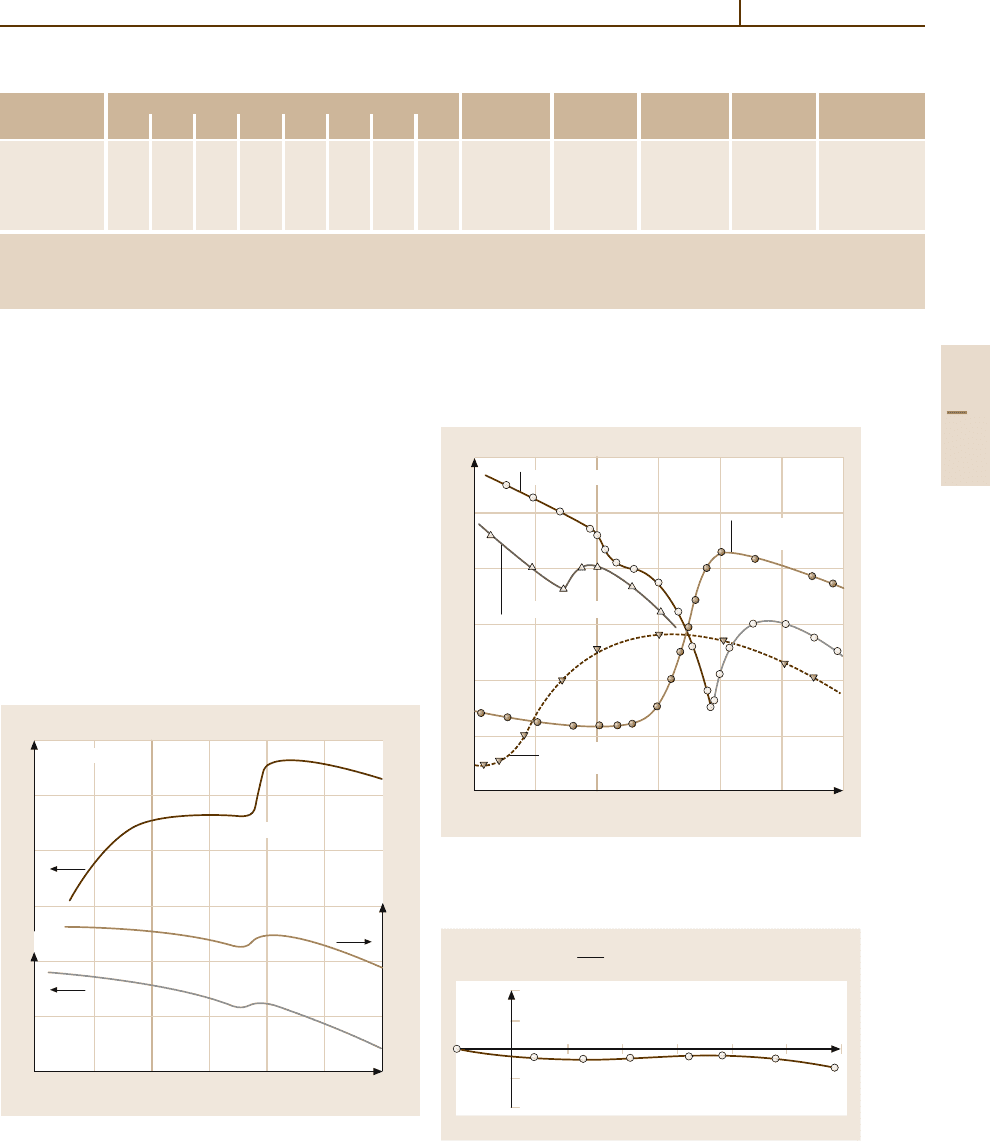
Magnetic Materials 3.2 Soft Magnetic Alloys 791
Table 4.3-30 Co
−
Fe-based elinvar-type alloys (annealed state). Composition, thermal expansion coefficient α, cont.
Composition in wt% α
a
E
b
e
c
G
b
g
c
Co Fe Cr V Mo W Mn Ni (10
−6
K
−1
) (10
10
Pa) (10
−5
K
−1
) (10
10
Pa) (10
−5
K
−1
)
Velinvar 60.0 30.0 10.0 8.1 6.53 0.0
50.0 31.8 8.2 9.1 11.0 6.70 1.0
37.5 35.5 7.0 20.0 11.1 6.45 −0.6
22.5 43.5 4.0 30.0 12.3 5.66 −0.3
a
For the temperature range 10–50
◦
C
b
At 20
◦
C
c
For the temperature range 0–50
◦
C
temperature of Mn
−
Ni- and Mn
−
Cu-based alloys were
modified by additions of Cr, Fe, Ni, Mo, and W as well
as by suitable technological treatment in such a way
that useful thermoelastic coefficients could be reached.
However, the mechanical workability, the sensitivity of
elastic properties to the degree of cold-working, the
unsufficient spring properties as well the low corro-
sion resistance and high mechanical damping could not
satisfy the conditions of technical application. Figures
4.3-49 and 4.3-50 [3.17] indicate the temperature depen-
dence of E of some Mn
−
Ni- and Mn
−
Cu-based alloys.
Table 4.3-31 [3.17] lists the compositions and the ther-
moelastic and mechanical properties of this group of
alloys.
13
12
11
11
10
9
8
16
15
14
–200 –100 0 100 200 300 400
T(°C)
E (× 10
10
Pa)
E (× 10
10
Pa)
E (× 10
10
Pa)
Mn–Ni
22.4 wt% Ni
25.3
30.4
Fig. 4.3-49 Mn
−
Ni binary alloys. Young’s modulus E vs.
temperature for alloys annealed at 1223 K for 1 h after cold-
working [3.17]
By optimization of the chemical composition and the
processing technology, an Fe
−
24Mn
−
8Cr
−
7Ni
−
0.8Be
–200 –100 0 100 200 300 400
15
14
13
12
11
10
9
T(°C)
E (× 10
10
Pa)
Mn–5 at.% Cu
Mn–25 at.% Ni
Mn–17.5 at.%
Cu–10 at.% Ni
Mn–17.5 at.%
Ni–10 at.% Cr
Fig. 4.3-50 Temperature dependence of Young’s modu-
lus E [3.17] for various Mn-based alloys annealed at 1223 K
for 1 h and then quenched
–2
–4
–10
0
20 30 40 50 60
4
2
10
T(°C)
Relative
frequency change
∆
(× 10
3
)
f
f
0
Fig. 4.3-51 Temperature dependence of the frequency of
a screw spring [3.53]
Part 4 3.2
